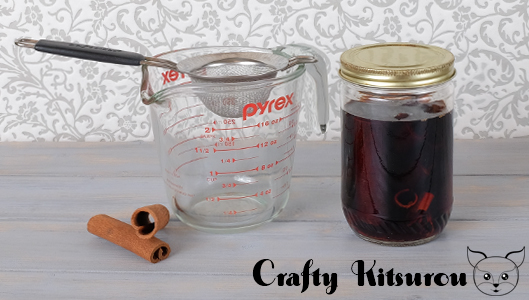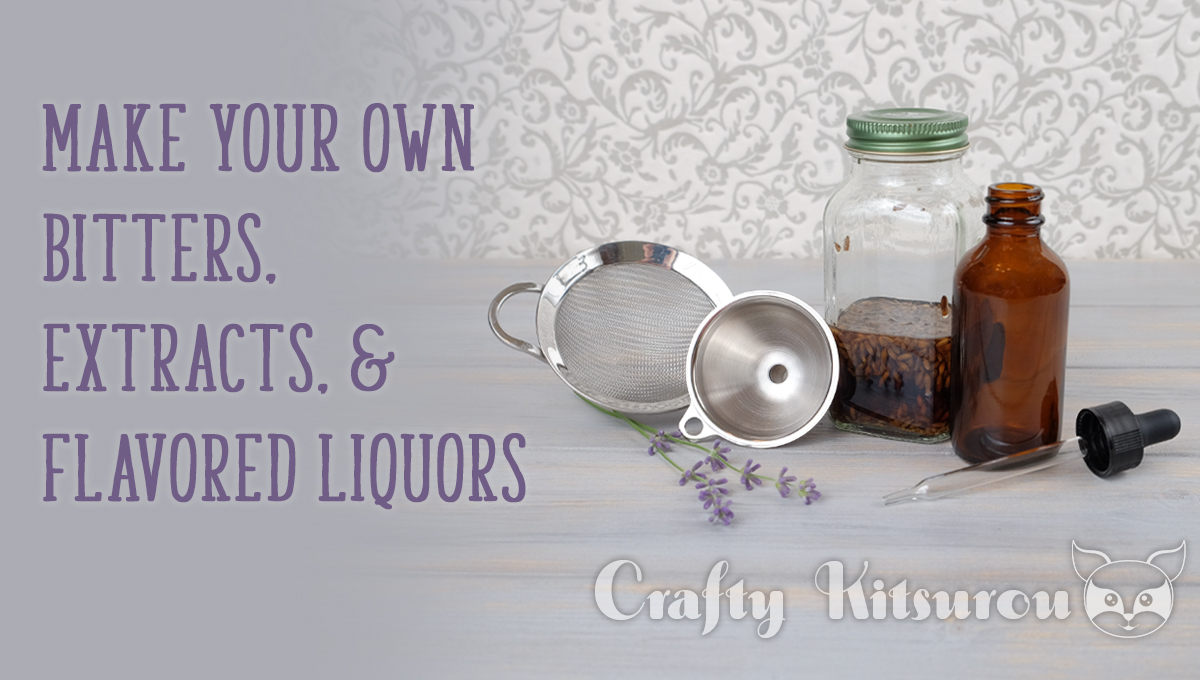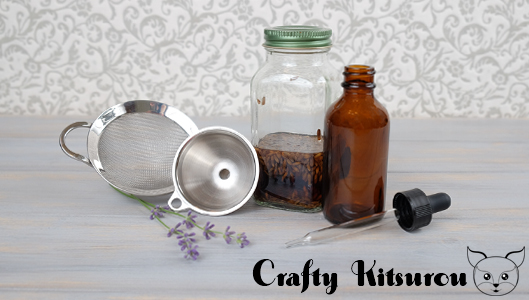Buying special liquors and bitters can get expensive real quick, and some flavors are hard to find. Also, I don’t always need a giant bottle of every flavor. Making my own bitters, extracts, and flavored liquors combines three things I love: variety, saving money, and saving space.
Making your own bitters, extracts, and flavored liquors is super easy, and the flavor possibilities are practically limitless. Basically, you can flavor any high-proof (100 or higher) alcohol with your favorite fruit, vegetable, herb, spice, or nut.
What’s the difference between bitters, extracts, and flavored liquor?
They’re all almost the same, and are made the same way. All of them are tinctures, meaning the flavor of a plant material is extracted in alcohol. The difference is really in the flavors you use, how strong you make it, and how you use it.
Bitters: Bitters usually consist of multiple flavoring agents, with at least one being bitter. Commonly used bitter ingredients are orange peel, cinchona bark, cassia, gentian, and cascarilla. Bitters are very strong, and usually have a complex flavor. Only a few drops are used at a time in drinks.
Extracts: Extracts usually consist of just one flavor. People often associate extracts with baking, but they’re much more versatile. They can also be used in drinks the same way as bitters. Extracts are also very strong, and only a few drops are used in drinks.
Flavored Liquors: The biggest difference between a flavored liquor, and extracts & bitters, is the amount you will be consuming. Anytime you want to use a teaspoon or more in your drink, I use the term flavored liquor. This means you want it less strong than bitters or an extract. Also, you can experiment with different types of alcohol for different results. For example, half a shot of mint rum is pretty good in black tea.
For extracts and bitters you typically want to use vodka or grain alcohol because they have a fairly neutral flavor, and you want taste the flavor of what you are infusing it with.
For flavored liquors, use the distilled alcohol of your choice such as vodka, gin, rum, whiskey, bourbon, scotch, or tequila.
Keep in mind the flavor of the liquor you choose will come through, so not all combinations will taste good. For example, I like cucumber gin, but I’m not sure how cucumber whiskey would taste. (Then again, maybe it’s really good. The only way to know for sure is to try it. So, you try it, and let me know how it turns out.)
You can use your bitters, extracts, and flavored liquors in a variety of foods and drinks. Obviously, you can use them in your alcoholic cocktails. But you can also use them in your favorite non-alcoholic beverages. For example, use a few drops (5-20) to flavor sodas, sparkling water, hot chocolate, coffee, or lemonade.
You can also use them to flavor foods like puddings, frostings, or syrups. Don’t limit yourself to desserts, they can also be used in savory dishes.
Quick note: The results may not be as consistent or as strong as the baking extracts you purchase in the store. I don’t usually use them in baked goods where the flavor is necessary and I cannot taste the batter. For example, I don’t use my homemade vanilla extract in cakes. Instead, I use it in beverages.
Ready to start infusing?
Here’s the super simplified instructions:
- Add fruit, vegetable, herb, spice, or nut to liquor of choice.
- Allow to infuse for 1 day to a few weeks.
- Shake every day or so.
- Strain.
That’s it.
What? You want more information? OK, here you go…
How to make bitters, extracts, and flavored liquors.
Supplies
- Glass container with lid
- Fresh or dried botanicals, herbs, fruit, or vegetable of your choice
- High proof alcohol
- Stainless steel strainer
- Cheesecloth or coffee filter
- Clear measuring cup
- Container to house your completed boozy goodness like a glass bottle with dropper, or a Mason jar
Getting Started
First, you will need a container to infuse the alcohol in. If I am making a small amount, I use a cleaned out spice jar. For larger quantities, use a mason jar. (I use the glass jars leftover from my peanut butter.)
Place your flavoring agent(s) into your container, and then add the alcohol.
What are the ratios of ingredients to alcohol?
There is no specific ratio that you must follow. Here are some guidelines for bitters and extracts that you may feel free to follow, or not follow:
For dried botanicals/herbs/fruit, use around 1 part flavoring agent to 4 parts alcohol.
For fresh botanicals/herbs/fruit/vegetable, use around 1 part flavoring agent to 2 parts alcohol.
For flavored liquors, use more alcohol because you want the taste of the flavoring agent to be more subtle than bitters or extracts. Try 1:6 for dried ingredients, and 1:3 for fresh ingredients. (Or not, I make a ridunkulously strong cucumber gin with 1 part cucumber to 2 parts gin.)
Dried foods are stronger in flavor than fresh, which is why you use more alcohol. Generally, you want to cover the item you are infusing with the alcohol, plus some. Keep in mind, if you are infusing an item like dried fruit, the fruit will swell over time, so make sure you use enough alcohol and leave enough room to compensate for this.
Remember, there is no “right” or “wrong” ratio to use. The bottom line is make what tastes good to you. I would err on the side of too strong, because you can always add more alcohol later on to dilute your tincture.
How long do I infuse for?
This depends on the ingredient(s) you are infusing. Some ingredients like fresh mint and basil, you only want to infuse for 1-2 days. Any longer, and the alcohol will start to take on a distinctly unpleasant vegetal taste with a hint of rotting compost. Not what you want.
Many other ingredients will continue to flavor the alcohol pleasantly for a few weeks, and the longer you infuse, the stronger the flavor. Luckily, you won’t hurt anything by trying it every few days. That way you can make it exactly the way you like it. Note: if you are making a flavored liquor, you can try it straight. If you are making an extract or bitter, try a few drops in water. Trying it straight will not be great. Have you ever tried vanilla extract straight? Blech.
Shake
Give your concoction a shake every day or so while it’s infusing. (I totally don’t do this every day. That’s because I forget, so sometimes I skip a few days.)
Strain

When it is done, you will strain out the ingredients. Start by staining through a stainless steel strainer. If there are still solids in your tincture, strain it again, this time through a filter like a cheesecloth or a coffee filter. Pre-wet the filter, because it will soak up a good portion of whatever liquid touches it first. You do not want to waste your tincture, so by pre-wetting with water, it decreases the amount of tincture it will absorb.
You can either use the filter to line the sieve or a large funnel. Slowly pour your tincture through the filter. Depending on what kind of filter you use, it can strain through very slowly. This is one reason why I prefer cheesecloth to coffee filters. Coffee filters are SLOW.
I usually strain into a clear measuring cup, that way I can easily see if it needs to be strained again. Once fully strained, I pour it into it’s new home with the aid of a funnel.

I would love to tell you that I then print out a lovely little label to put on the bottle, but I can’t. Who has time for that? I’m already making my own tinctures, I think I’ve done enough. I slap on some masking tape, write on it with a sharpie, and call it a day.
Mo’ Better Bitters
Remember how I said bitters usually use multiple ingredients? There are two ways you can handle this. You can put all your ingredients in one jar, and infuse your new bitters as a whole. Or, you can infuse each ingredient separately, and then mix the resulting multiple bitters together after the fact.
I prefer to infuse each ingredient separately, because it gives you more flexibility. First, you can play around with the ratios and immediately taste it to see what you like. If you infuse everything together and wanted to make changes, you would have to make a new batch and wait another week or more. Second, you can easily mix and match your bitters for each drink. It’s win-win.
What’s in my cabinet?
Here are some of my favorites to make that are always in my liquor cabinet. (Ratios are approximate. I don’t measure, I mix by sight.)
- Lavender: 1 part dried culinary lavender + 4 parts vodka
Infuse for 1-4 weeks. I use this for alcoholic and non alcoholic beverages. Try 5-10 drops in lemonade, or with a cocktail using cucumber gin.
- Cinnamon: 1 part cinnamon sticks + 2 parts vodka
You can coarsely break up the cinnamon sticks first. Infuse for 1-4 weeks. It’s great in hot chocolate, tea, and coffee.
- Nutmeg: 1 part nutmeg + 4 parts vodka
Use freshly grated nutmeg. Infuse for 1-4 weeks.
- Orange Peel: 1 part dried orange peel + 4 parts vodka
Infuse for 1-4 weeks.
- Clove: 1 part cloves + 4 parts vodka
Infuse for 1-4 weeks.
- Vanilla: 1 part vanilla beans + 4 parts vodka
Infuse for 1-4 weeks. I actually never remove the beans. I pour a small amount into a bottle with a dropper, and leave the remainder with the beans in the large jar. I just keep refilling the small bottle from the large.
- Mint Rum: 1 part fresh mint + 2 parts rum
Only infuse for 1-2 days. As soon as the mint leaves lose their green color, take them out! If you leave them in any longer, it will taste like rotten plant matter. You can use either white rum or golden rum. I like to add a splash of this to black tea.
- Cucumber Gin: 1 part cucumber + 2 parts gin
I like a super strong cucumber flavor. If you do not, try a 1:4 ratio instead of 1:2. Peel the cucumber and slice it around 1/4” thick. (No need to bust out the ruler, that’s just a guide.) I let it infuse until the cucumber slices are completely bleached. After straining, I keep the cucumber slices in an airtight container in the fridge. My husband likes to eat them, he calls them “Gin Pickles”.
- Cherry Brandy: 1 part cherry + 4 parts brandy
Cut cherries in half, and remove the pits. Infuse for 1-4 weeks. Save the cherries after straining, and try one on a sundae!
Remember: If the flavor is not strong enough, you can add more flavoring agent and/or infuse for longer. If the flavor is too strong, you can dilute the finished product with more alcohol.
Bitters Blends
Try the following combinations. The ratios I provided are just a guide, play around with the ratios to get what is pleasing to you.
- Pumpkin Spice #1: 4 parts Cinnamon, 4 parts Nutmeg, 1 part Clove
- Pumpkin Spice #2: 4 parts Cinnamon, 3 parts Nutmeg, 1 part Vanilla, 1 part Clove
- Christmas Blend #1: 4 parts Cinnamon, 3 parts Nutmeg, 2 parts Vanilla, 1 part Orange
- Christmas Blend #2: 4 parts Cinnamon, 2 parts Vanilla, 2 parts Orange, 1 part Clove
- Cucumber Lavender: 4 parts Cucumber, 2 parts Lavender, 1 part Orange
- Cherry: 6 parts Cherry, 1 part Orange, 1 part Clove

